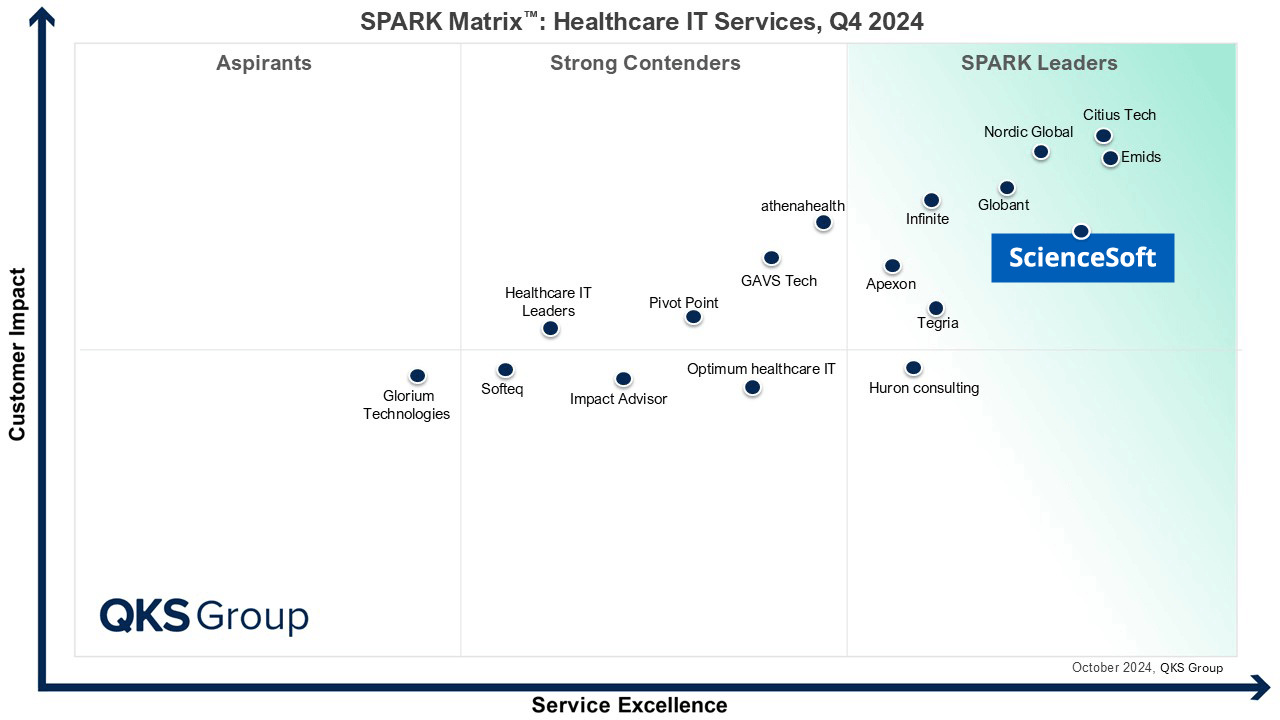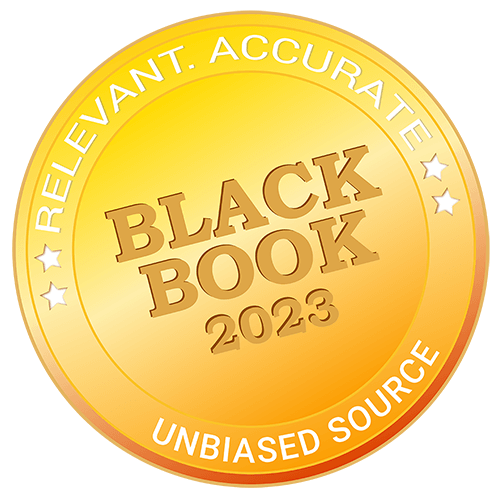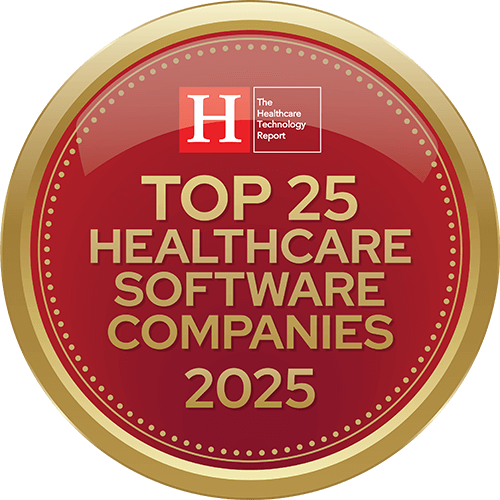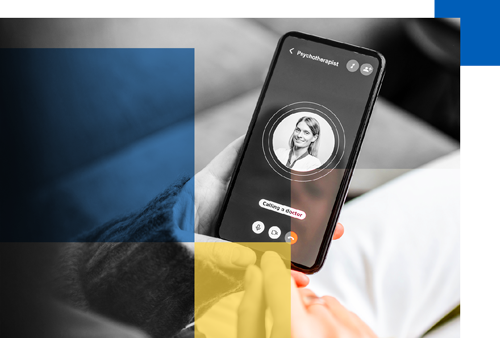Mental Health App Development
A Complete Overview
Drawing on 36 years of experience in software development, ScienceSoft builds high-quality HIPAA-compliant mental health applications featuring virtual care, self-assessment, prescription and medication management, goal setting, therapy progress monitoring, crisis intervention, and more.
Mental Health Apps: The Essence
Mental health app development aims to create accessible, reliable applications that allow mental health patients to get remote professional help and monitor their condition in a guided mode.
- Key steps: business analysis, architecture design, project planning, UX and UI design, coding, testing, launch, maintenance, and evolution.
- Team: project manager, business analyst, software architect, UX and UI designers, DevOps engineer, mobile and backend mental health applications developers, QA engineer, regulatory consultant, cybersecurity specialist.
- Costs: from $150,000 (for a robust application with back end) to $800,000+ (for a sophisticated solution with complex back end and advanced functionality). Turn to our easy-to-use cost calculator to get a tailored quote and navigate your project finances confidently.
The Mental Health App Market
The global mental health app market is projected to reach $17.52 billion by 2030, growing at a CAGR of 14.6% from 2025 to 2030. The increased use of mental health applications to improve treatment outcomes and patient lifestyle is among the key factors contributing to the market expansion.
Core Features of a Successful Mental Health App
Since 2005, ScienceSoft has delivered over 150 effective healthcare applications. In our mental health software development projects, we pay special attention to the market demand and our clients' business goals to create user-centric apps that continue to bring value in the long run. Below, our consultants list the core mental health app features most commonly requested by end users and our clients in the healthcare industry.
Sample Architecture of a Mental Health App
ScienceSoft's experts share an example of microservices-based architecture and outline its key building blocks.

Microservices-based architecture is a good choice for complex mental health applications. Each service runs independently, so it's easy to deploy, scale, and maintain them separately. Also, if one microservice fails, this does not affect the other services.
Mental Health App Development Roadmap
During our 20 years in healthcare IT, ScienceSoft has realized over 350 diverse initiatives. Though each project is unique, it's still possible to define common steps and sample timelines. The roadmap we share below will help you better understand how to develop a mental health app and plan your project effectively.
1.
Discovery
- Defining the goals and conceptualizing the app.
- Analyzing the market, audience, and competitors in the relevant mental health care niche.
- Assessing the feasibility of implementing the planned digital mental health intervention.
- Listing and prioritizing the app features.
- Identifying compliance requirements for the app (e.g., with HIPAA, HITECH, FDA, FTC, NCPDP, OCR, CFR 42 Part 2, GDPR, EU MDR).
- Determining the types of personal data that will be collected, processed, and transferred by the app.
- Modeling consent to process a data subject's information.
- Planning data access control, data archival and clearing mechanisms, encryption for at-rest and in-transit data.
- Helping decide on the data retention period.
- Creating detailed Data Flow Diagrams (DFDs) to identify potential privacy issues.
- Defining the required integrations, identifying suitable interoperability standards (e.g., HL7, FHIR, CCDA), datasets (e.g., USCDI), and clinical terminologies (e.g., LOINC, SNOMED CT, RxNorm).
- Creating a business case, estimating the development cost and ROI.
Some mental health apps collect data for personal use only. If your app is no different, it is not subject to HIPAA compliance. But if your app gathers patient data and shares it with healthcare providers, insurance companies, business associates, or any other entity, you must comply with HIPAA.
2.
Requirements engineering and software architecture design
- Determining functional and non-functional requirements for the app.
- Creating compliance specification with references to pertinent clauses of standards and regulations (HIPAA, CFR 42 Part 2, etc.).
- Translating regulatory compliance requirements into mental health software requirements.
- Deciding on the resilient software architecture.
- Designing the needed integrations.
- Selecting a secure technology stack to support compliance with the necessary regulations and standards.
The visual accessibility of mental health apps makes a big difference for people who have vision impairments (e.g., blurred vision) caused by severe anxiety or depression. To enhance the app's visual accessibility, you may consider having your application integrated with assistive technologies like a screen reader or screen magnification software. Users may also benefit from the mental health app being integrated with alternative input tools such as speech input software or single switch entry devices.
3.
Project planning
- Selecting a project management approach (e.g., Scrum, Kanban).
- Deciding on the project timeline, milestones, resources, and budget.
- Defining tangible KPIs (e.g., user engagement metrics, such as daily active users, retention rate, and session lengths) for project health and progress assessment.
- Evaluating the project risks, conducting Privacy Impact Assessment (PIA) of the app, analyzing PHI breach risks, and drawing up a risk mitigation plan.
- Hiring or outsourcing the needed IT resources.
4.
UX and UI design
- Creating user personas and user scenarios (e.g., attending group therapy sessions).
- Visualizing the app's core functionality via UI prototyping.
- Mapping convenient user journeys and building UX wireframes.
- UX testing.
- Designing the visual interface of mental health software in accordance with the defined visual accessibility requirements.
- Creating precise easy-to-understand consent forms and privacy policy that describes the data processing methods, data storage period, and third parties with access to the data.
5.
Iterative development and testing
- Designing a secure development infrastructure compliant with HIPAA, GDPR, etc.
- Setting up the environments for development and delivery automation (e.g., container orchestration, CI/CD).
- Developing the app's front end and back end, following the OWASP guidelines on secure coding.
- Implementing security features (e.g., encryption of PHI at rest and in transit, role-specific access control, multi-factor authentication).
- Establishing PHI backup mechanisms, PHI breach detection, and breach notification processes.
- Integrating the mental health application with the required devices, third-party apps, payment gateways, etc.
- Conducting QA in parallel with the development.
- Carrying out code review, compliance checks, static and dynamic application security testing, pentesting; resolving the detected vulnerabilities.
At ScienceSoft, we often offer MVP (minimum viable product) development as the first step. It helps to quickly validate the software idea, launch the product on the market, get early user feedback, and confidently evolve the product further.
6.
Pre-launch activities and release
- Revising the project documentation for consistency and certification compliance, e.g., with ISO 13485 and IEC 82304-1:2016.
- Conducting a HIPAA compliance assessment or GDPR compliance audit (if necessary).
- Obtaining approval from FDA.
- Carrying out the final review of security controls in the mental health software infrastructure and preparing an incident response plan.
- Rolling out the app's pilot version to the focus group to get feedback and introduce improvements, if needed.
- Launching the application.
If your mental health app has SaMD features, an additional step must be taken during the pre-launch phase: submitting the rolled-out pilot to the regulators. If they respond positively, the app can go to the market. Also, if your app introduces new treatments, clinical trials should be conducted first.
7.
Maintenance and evolution
- Implementing updates for full compatibility with new OS versions, managing user issues, optimizing cloud resource consumption, performing security audits, and more.
- Adding new mental health application features and integrations, adjusting UX and UI as needed.
- Planning software migration to a HIPAA-compliant cloud (e.g., AWS, Azure).
- Re-designing the app architecture for PHI protection improvement.
Consider Professional Services for Mental Health App Development
In medical IT since 2005, ScienceSoft knows how to develop highly efficient and compliant mental health applications for convenient and safe care delivery. You set goals, we drive the project to fulfill them in spite of time and budget constraints, as well as changing requirements.
Our Clients Say
We are thankful for the meticulous and value-driven approach of ScienceSoft’s team. They created comprehensive project documentation, feature lists, and worked out thorough recommendations to help us improve the stability and performance of our solution. ScienceSoft’s project manager, business analyst, QA and software engineers were always friendly and ready to answer our questions or solve any ad-hoc issues. ScienceSoft proved to be a reliable vendor with a solid healthcare background, and we recommend them to everyone looking for a telehealth software development partner.
Todd Nilson, MD, HealthPoint Plus
Why Your Mental Health App is Destined to Succeed with ScienceSoft
- Since 2005 in mobile app development and healthcare IT, 150+ successful healthcare IT projects.
- Professionals with 7–20 years of experience, including project managers, healthcare software architects, data scientists, cybersecurity specialists, and regulatory consultants.
- Vast expertise in AR/VR, AI/ML, big data, IoT.
- Strong Lean, Agile, and DevOps cultures.
- Research-based UX/UI design made to be convenient for medical staff and patients.
- Proficiency in healthcare standards (e.g., HL7, ICD-10, LOINC, CPT, XDS/XDS-I, FHIR, DICOM).
- Experience in developing software compliant with SAMHSA guidelines, HIPAA, HITECH, FDA, FTC, NCPDP, OCR, CFR 42 Part 2, GDPR, EU MDR, etc.
- Mature quality management system backed by ISO 13485 and ISO 9001 certifications.
- ISO 27001 certification to guarantee full security of our clients' data.
Our awards, recognitions, and certifications

Featured among Healthcare IT Services Leaders in the 2022 and 2024 SPARK Matrix
Recognized for Healthcare Technology Leadership by Frost & Sullivan in 2023 and 2025
Named among America’s Fastest-Growing Companies by Financial Times, 4 years in a row

Top Healthcare IT Developer and Advisor by Black Book™ survey 2023
Recognized by Health Tech Newspaper awards for the third time (2022, 2023, 2025)

Named to The Healthcare Technology Report’s Top 25 Healthcare Software Companies of 2025
ISO 13485-certified quality management system
ISO 27001-certified security management system
Key Roles on Our Mental Health App Development Teams
The project team composition varies depending on the service option and its scope. Below, ScienceSoft presents the most common roles.
Project manager
Plans the mental health app project; ensures solution delivery in accordance with the project objectives, time frames, and budget; mitigates risks; reports to the stakeholders.
Healthcare IT consultant
Helps analyze the mental health niche the app will address, define compliance and registration requirements and translate them into the app’s requirements, outline functionality and integrations.
Software architect
Designs the optimal mental health app architecture and integrations with other software or third-party services (e.g., EHR, practice management system, billing software); selects a fitting technology stack.
UX designer
Identifies user personas and scenarios; designs end-to-end journeys of app users (i.e., patients and behavioral specialists); creates UX wireframes and prototypes; tests mental health app accessibility and usability.
UI designer
Creates an intuitive, soothing, chromotherapy-based visual interface; turns UX wireframes into UI design.
DevOps engineer
Sets up and maintains mental health software development infrastructure; builds CI/CD pipelines to automate deployment; chooses and configures security, performance, and availability monitoring tools.
Mobile developer
Creates the sleek GUI elements; fixes the bugs reported by QA engineers.
Backend developer
Builds the server side of the mental health app with a focus on security and regulatory compliance; creates the business logic; eliminates the bugs reported by the QA engineer.
QA engineer
Devises a test strategy and a test plan; creates test cases and scenarios; introduces test automation; reports bugs and validates their fixes.
Regulatory consultant
Gives recommendations on the architecture components of the mental health software, secure techs, and development process to ensure the app's compliance with the necessary regulations, e.g., HIPAA, HITECH, GDPR.
Cybersecurity specialist
Verifies app requirements, architecture, and code from the cybersecurity perspective; assesses healthcare data privacy and security risks.
Data scientist*
Creates and validates the data sets for machine learning algorithms; designs, trains, and tunes ML models.
*For AI/ML-powered apps
Key Sourcing Models for Mental Health App Development
Technologies We Work With
Low-code development
QA tools
DevOps
Containerization
Automation
CI/CD tools
Monitoring
Telehealth
Video streaming
Messaging and conferencing
How Much Does It Cost to Develop a Mental Health App?
The cost of mental health app development may vary from $150,000 to $800,000+, depending on the solution's functionality and complexity, the number of integrations, and the required team composition.
$150,000-$250,000
For a complex mental health app having back end and covering several aspects, from daily self-care to virtual appointments (integrated with EHR).
$250,000–$800,000+
For an advanced solution with a robust back end featuring advanced capabilities (e.g., VR-based exposure therapy), enhanced cognitive accessibility, telepsychiatry, digital therapeutics, and all the required integrations (e.g., EHR, wearables, or medical devices).
Get to Know the Cost of Your Mental Health App
Relying on the experience gathered in over 150 healthcare IT projects, we will help you calculate the cost and ROI of your mental health app.
About ScienceSoft
ScienceSoft is an international IT consulting and software development company headquartered in McKinney, TX. Since 2005, we have been delivering highly reliable and efficient healthcare solutions. In our projects, we use a mature quality management system supported by ISO 13485 and ISO 9001 certifications as well as a robust ISO 27001-certified security management system.











